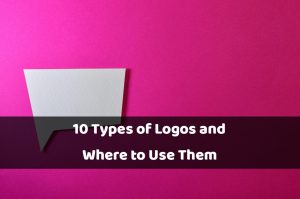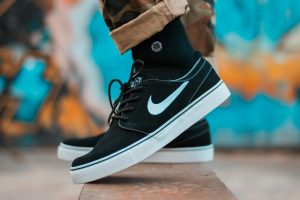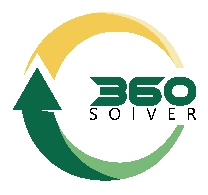10 Types of Logos and Where to Use Them
Choosing the correct Logo is one of a firm’s most essential early brand decisions.
It’s similar to picking out your outfit for that exciting first date. Your desired mood is reflected in your Logotype: Trendy and sophisticated or unconventional and creative? Here’s where you get creative about your logo design: The outdated hoodie or the luxurious cardigan?
First impressions matter. This is also applicable to brands. A vital part of the first impression is your Logo, which conveys your company identity, principles, and method. It may instantly separate your brand from the crowd and give it a memorable, recognizable look.
Things to Think About When Selecting the Type of Logo
You can focus on a smaller selection of logo styles by answering a few critical questions:
The first thing to do is to decide what message you wish to convey. Consider where and how the company will use the Logo. Then there are your industry and opponents to think about. How can you distinguish your brand from the competition while clarifying its place in the market?
When selecting a sort of Logo, keep the following points in mind to help you decide on an answer:
- values, identity, and personality. Certain logo forms are more suited for humor or originality, while others convey legacy and durability. Whatever path you take, the Logotype should match the company’s overall positioning.
- adaptability and expandability. How and where will the company use its Logo? To avoid reworking the Logo when demands change, you (or your client) want as much flexibility as possible. On a phone screen, a complicated logo that appears excellent on a billboard may be unreadable. Consider every possibility that could happen.
- Industry. Brands in related industries frequently use similar logo designs. However, there are valid arguments for breaking tradition. For instance, a young-focused finance company would want a more informal logo to set itself apart from its larger competitors.
- Distinctiveness and memorability. Your Logo needs to be memorable. Customers should be able to recall and recognize a well-designed logo, which may be achieved with the right Logotype. While there may be valid reasons to go with a popular type in your field, making a statement should always come first.
- Current trends. Whether you keep up with the latest trends or not, what’s popular right now, and what you’re trying to say when you choose a trending logo style over a more traditional one.

10 Types of Logos and When to Use
Wordmark
A foundation for wordmark logos, also known as logotypes, is typically the title of a company.
With its ability to interact with many brand identities, the wordmark logo is an excellent choice for companies with short, memorable names. Consider how different the Samsung and Barbie logos are to understand how adaptable this typeface is.
Technology companies, advertising agencies, and service-oriented enterprises frequently use wordmark logos. Additionally, they can be found in well-known, long-standing companies.
Advice: Choosing the correct font is essential for a wordmark logo. Make sure the font you choose or create represents the essence of your brand and is readable and transparent in all sizes. If your brand name is lengthy or intricate, there are better options than wordmark logos.
Examples: Google, Coca-Cola, Fender, LEGO, Canva
Watermark
An initial or set of letters makes up a lettermark logo. You have a letterform logo if there’s just one letter.
Monogram logos, sometimes called lettermark logos, are an excellent choice for companies with lengthy or complex names. Letter marks enable a harmonious relationship between a powerful visual brand and high name recognition. Additionally, there is space for subtle visual play. For instance, the “A” in the Airbnb logo is changed to resemble a heart shape and a map pin icon.
The letter mark Logo is used in many industries but is frequently associated with premium labels and well-known companies.
Pro tip: When creating a lettermark logo, legibility, simplicity, and clarity are essential. Consider your spatial and visual design thoroughly, regardless of whether you want a linked monogram or a single letterform.
Examples: IBM, Chanel, Under Armour, Airbnb
Pictorial mark
An icon or symbol in graphics is used in this kind of Logo. It might be an image of the brand name or an associated symbol.
Images are recognized and remembered by humans far more quickly than words. Consequently, a visual mark is a practical approach to stand out.
Social media sites, creative or tech businesses, and consumer brands regularly apply pictorial marks.
Expert advice: Go for a simple, iconic design that shrinks the spirit of your company into one unforgettable picture. The most successful visual marks are apparent, essential, and neat. Avoid using extraordinarily evident or overused images since this could lead to confusion about your brand.
Examples: Shell, Snapchat, World Wildlife Foundation, Playboy
Abstract logo mark
Using a geometric or symbolic shape, an abstract logo mark does not represent a specific thing.
Abstract logo marks require little judgment when done correctly. One such example is the Nike Swoosh logo, which symbolizes the brand’s emphasis on athletics, performance, and achievement while conveying a sense of motion, speed, and energy.
Additionally, you are free to use these logos in various media. They also make it possible to utilize color and shape creatively to gather feelings, which may be an effective branding tactic.
Abstract mark symbols are frequently linked to well-known IT businesses, financial institutions, and sports brands.
Expert advice: Create an abstract mark consistent with your company’s positioning, goal, and essential values. Your Logo must have emotion and meaning for your target audience, whether abstract or geometric.
Examples: Adidas, Mastercard, Olympic Circles, Reebok
Combination Mark
Combined symbol To create a combination of word and image, logos (sometimes called “combination marks”) combine an abstract or graphical mark with a wordmark or lettermark.
Combination marks instantly capture the core of a company’s personality and identity and are frequently the first logotypes created for new brands. With this kind of Logo, you can simultaneously increase brand name familiarity and visual identity.
Expert advice: When creating a combination mark logo, go for a logical design in which the words and image work well together to convey a robust and compatible brand story. Recall that each component can also be employed independently after solid brand recognition.
Examples: Doritos, Puma, Timberland, Burger King
Emblem Logo
An effective emblem logo provides a story about ideals, history, and personality. They are frequently used for shields and banners of arms as an outcome. Additionally, a symbol can convey a powerful statement regarding authority and durability.
Universities, government agencies, high-end vehicles, trade associations, and brands that want to project authority and stability frequently use emblem logos.
Pro tip: A logo should accurately represent the history and values of your company without sacrificing readability. The goal is to reduce unnecessary detail while maintaining clear communication of the identity and narrative of your business. Remember scalability: Large billboards, digital screens, little business cards, and merchandise frequently feature emblems.
Examples: Harley-Davidson, NFL, Harvard University, NASA
Mascot Logo
Mascot logos are relevant and entertaining. They consequently instantly personalize a brand.
Robust design of characters and a keen understanding of the corporate narrative are essential for creating a memorable mascot logo. The mascot logo should be easily recognized and utilized consistently across all platforms and media, just like many of the other logos.
It can be challenging to create a logo that generates an emotional response that is universally good. When used correctly, this logo style can become unique and develop a powerful brand identity.
This Logo can be used by brands that wish to appeal to children or inspire nostalgic or playful feelings associated with childhood.
Pro tip: Create a mascot logo that symbolizes your brand’s mission and has a strong character and narrative. Your mascot should evoke strong feelings in viewers’ minds, encouraging involvement and connection. Make sure the design of your mascot is distinctive enough to be identified without the name.
Examples: Mr Monopoly, KFC’s Colonel Sanders, Wendy’s, Reddit
3D Logo
With shadows, gradients, and highlights, 3D logos are intended to jump out of the page or screen and have a physical presence.
Any letter mark, wordmark, pictorial, or abstract Logotype can be made to appear three-dimensional by an experienced designer.
Most commonly, 3D logos can be found in the automotive, home appliance, and electronics industries.
Pro tip: Make “Less is more” your guiding principle. If not, this kind of Logo could be confusing. Should you decide on this, keep an eye on trends since static 3D logos can soon go out of style. Combined motion graphics and 3D elements are currently popular, and they use revolving 3D symbols behind a stationary wordmark to communicate a dynamic, innovative company identity.
Examples: Chevrolet, Firefox, Porsche, LG
Dynamic Logo
One result of the digital era is dynamic Logo. These logos adapt to various media and circumstances because they are not limited to a single colorway, orientation, or shape.
Due to their extreme adaptability, dynamic logos are frequently used by big organizations with numerous divisions or cross-platform presences. Additionally, they can represent shifting conditions—a technique employed by Nordkyn Peninsula, a weather service that modifies its Logo in response to temperature and wind direction variations.
Dynamic logos are an excellent option for creative, media, and IT firms looking to convey adaptability, creativity, and innovation.
Pro tip: Maintain golden threads of brand identity and recognition by ensuring your dynamic Logo’s essential components are consistent. You must specify exactly which parts are changeable and which are permanent.
Examples: MTV (multiple colorways), Nickelodeon (various platforms), OCAD University
Animated Logo
This kind of Logo, which frequently includes interaction and always has motion graphics, is growing in popularity.
Recently, memorable effects-driven animated logos have unlocked an intriguing realm of hybrid design: movement mixed with 2D or static elements (see what Hiplay accomplished), or the spectator encouraged to interact and play (Google is king here).
These logo forms are typically connected to tech, creative, and design brands showcasing their technical expertise and versatility.
Expert advice: While motion offers versatility and flexibility, make sure your animated Logo maintains the essence and character of your company’s static logos. Across all mediums, you want perfect uniformity and recognition.
Examples: Google Doodles, Microsoft 365, Meta, Shazam

Five New Logo Trends for 2024
The design and aesthetic preferences of the target audience are typically reflected in logo trends. Following the latest trends can make your Logo seem more modern and relevant, which is especially valuable in fields where staying current is essential.
Text Assortment
According to Prinsloo, using a wordmark logo sometimes means your design must comply with a set standard.
Put the text assortment logo here. “With this mix-and-match strategy, you can create unique designs that stray from the traditional corporate aesthetic by experimenting with different typefaces.”
Examples: Nobu, NinetySix Studios, Fabrik
Lowercase Lettering
In wordmark or lettermark logos, lowercase typography highlights simplicity and accessibility.
Prinsloo says this popular logo style is “playful, inviting, approachable and youthful.” Lowercase letters could be an excellent option if they reflect the essence of your brand personality.
Examples: Olby, Public Anchor, Tumblr
Animated and Special Effects
Animated logos are nothing new; do you recall the initial Google Doodle from Halloween 2000? According to Prinsloo, the current trend is to produce a “360-degree visual fiesta” rather than merely adding movement into a still image.
Mixing round, vector-based logos with dynamic or 3D features is a big trend in logo design for 2024, offering brands the best of both worlds.
Vivid rainbow colors and smooth gradients are in style right now.
Examples: Stage, HiPlay
Minimalism
Fans of the abstract mark now are our moment. Numerous well-known companies are choosing to update their logos in a minimalistic style.
Examples: Nokia, Instagram, Target
Handwritten and Imperfect
According to Prinsloo, it’s unsurprising that logos are embracing the unusual and odd and reflecting on handwritten charm and doodling in an era where it seems we’re never sure what’s real and what isn’t.
There is just one rule: rules are meant to be broken. “Look for logos that accept imperfections, such as handwritten notes, flowing lines, and errors.”
Examples: Yarky, Klapp, Centre for Social Innovation

Selecting the Correct Logo Type for Your Business
Creating a logo may be difficult, and making a brand memorable is challenging. Ultimately, the typical consumer is subject to a great deal of noise.
However, you may start down the proper path by choosing the appropriate logo type and researching competitors and trends.

